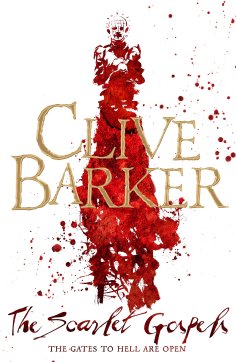
The Scarlet Gospels by Clive Barker
(Macmillan, 2015, 419 pgs)
The Cenobite Hell Priest, known as Pinhead, is murdering the Earth’s sorcerers, stealing their secret arts and abilities. Harry D’Amour is a private investigator and demon hunter – teamed with blind psychic Norma, they help spirits in need. When assisting one lost soul, D’Amour is accosted by the dreaded Cenobite: Norma is abducted by him and taken deep into Hell, where Pinhead begins his nefarious takeover of Hell. D’Amour, accompanied by his fellow occult specialist friends, descends into Hell itself, following Pinhead to rescue Norma, but finds Hell in utter chaos…
As a long-time fan of the Hellraiser film series, but new to Clive Barker’s literary works, I was still optimistic about this read – and I was not disappointed! With all the disgusting schlock and gore that the films are beloved for, but with more vivid imagery and horrifying splendour that the films lack, Barker’s recent foray back into the Hellraiser universe is a perfect mixture of everything you would want from a new Hellraiser tale.
D’Amour is likeable here – an exhausted occult P.I., riddled with bad habits, and with the sort of hard-boiled sarcastic personality that always seems, on the surface, largely unflappable when confronted by some of Hell’s worst. He is also deeply troubled and traumatised by past hellish experiences however, and when Norma is taken these come to the fore. Taking comfort in his friendship with Norma, and strengthened by the friends who accompany him on the way, D’Amour battles his own demons as well as Hell’s finest.
The plot of the novel is split into two sections – the first introduces Pinhead’s plans for Hell, a hostile takeover from the shadows, in which he plans with typically Machiavellian aplomb the assassinations of the other Hell Priests. Famously, Barker never liked the name ‘Pinhead’ (which was more a fan nickname), and so the character is largely referred to as ‘Hell Priest’ here, with ‘Pinhead’ often used as a thrown insult by the human characters opposing him. He is given more gravitas through this naming, whilst the name ‘Pinhead’ acts as a perfect way to reduce his emotionless facade and show the real insecure sadist hiding beneath. Fans of the Cenobite are rewarded with some particularly vile scenes of him doing what he does best – think lots of hooks and chains…
During this first section, we are introduced to Harry and the characters who later join him on his descent into Hell to rescue Norma. They consist of: Caz, a tattooist whose ink is imbued with protective sigils and enchantments; flamboyant prophetic dandy, Dale; and tough magic-fighter Lana – all of whom are close friends of Norma and allies of D’Amour.
It is during the second half of the novel, once the team has descended into Hell, that Barker’s imagination and the Hellraiser lore really come to the fore. We learn how bureaucratic elements of Hell really are, how Lucifer has gone missing for centuries, how demons have bred and created differing tribes of mutated ex-fallen angels, and how the Hell Priest Order itself is ran. We are introduced to the cities of Hell, mockeries of Fallen Rome, and we get a sense for the humdrum and misery that the dimension runs on. It is a place of towering castles of impossible architecture and of crumbling shanty towns. The lore of Hellraiser here is perfectly expanded upon in such a way that the films were unable to.
The Lemarchand Boxes or Lament Configurations, an often elusive motif in the movies, are here explained in more detail and make more sense in context. The Hell Priests order and their role is clarified too (though they still remain satisfyingly ambiguous in some regards) and the tying in of Lucifer is also done here with great imagination.
The descent into Hell is a fantastic narrative choice; mimicking Dante’s Inferno, but with a group of close LGBT occultist friends, flirting and fighting with each other every step of the way. The quest narrative is not just fuelled by the drive to stop Pinhead and save Norma, but is largely supported by their constant bickering and joking amongst themselves. They are likeable – as happy to shout expletives when they see something disturbing as they are to openly mock their demonic foes. They are not impossible to scare however, and when they come across the weirdest and most horrendous images to be seen in Hell, they are effected by it – but the strength they draw from one another made even these more disturbing scenes enjoyable to read. Though some may prefer their horror straight-faced, I loved this novel’s moments of humour. They strengthened the disturbing and uplifted the positive and worked within the universe perfectly.
Ultimately, I loved every moment of this novel and flew through it. The inclusion of added Hellraiser lore was particularly a favourite for me, and I greatly enjoyed the banter between the characters, even as Hell itself is tearing itself to pieces around them. Pinhead, of course, is perfectly written by his creator (who else) and has all the solemnity and sadism one would expect. A fantastic return to the Hellraiser universe. Even though the book can be seen as a conclusion to the series, I would love to see Barker write something along these lines again. It only goes to prove I have to read more his novels this year – so watch this space!
[5/5]
2 thoughts on “Recent Reads: The Scarlet Gospels by Clive Barker”